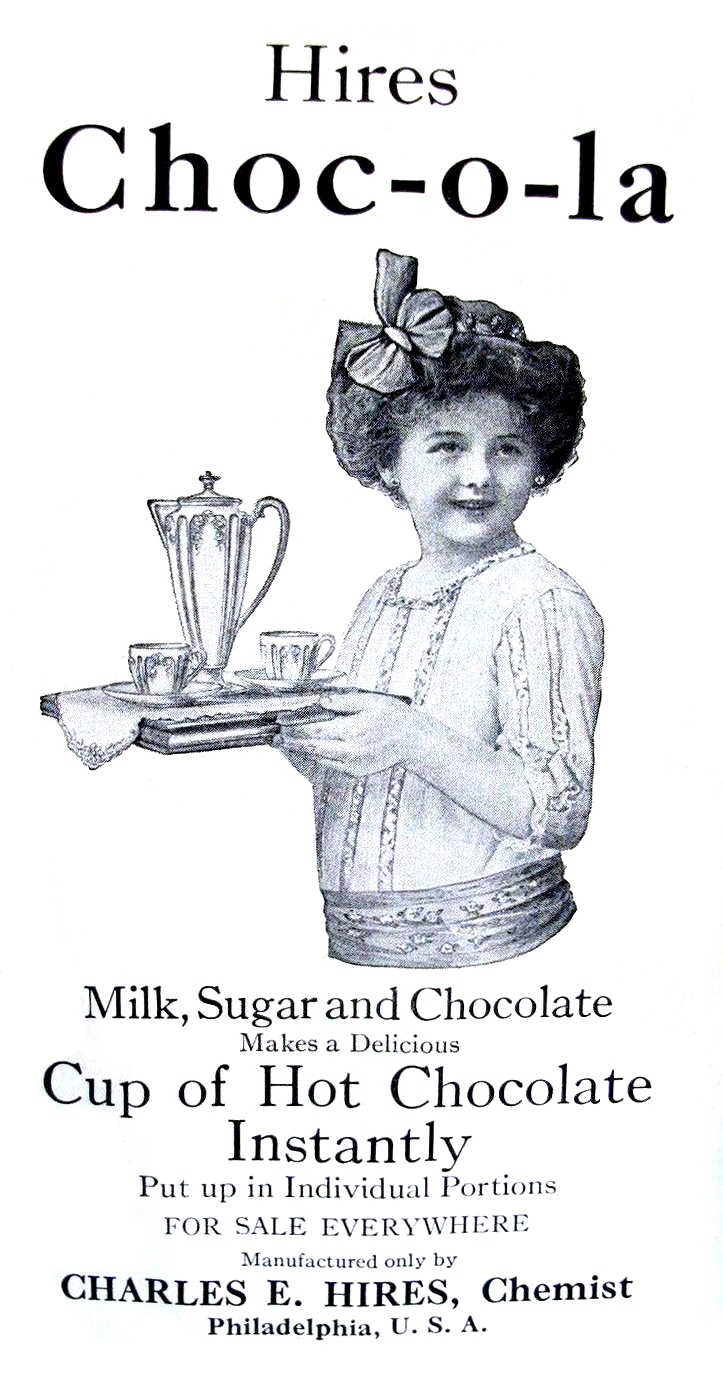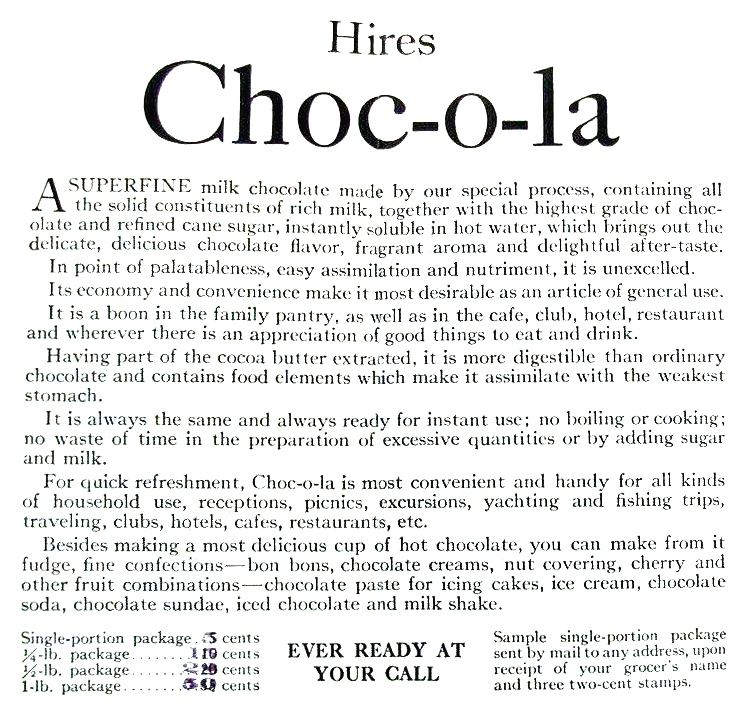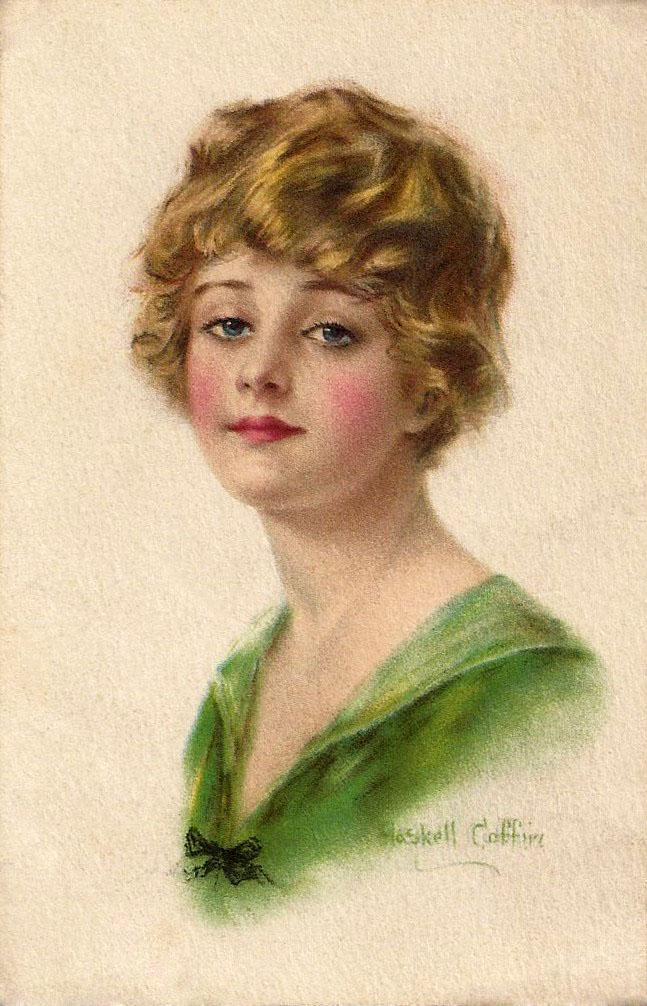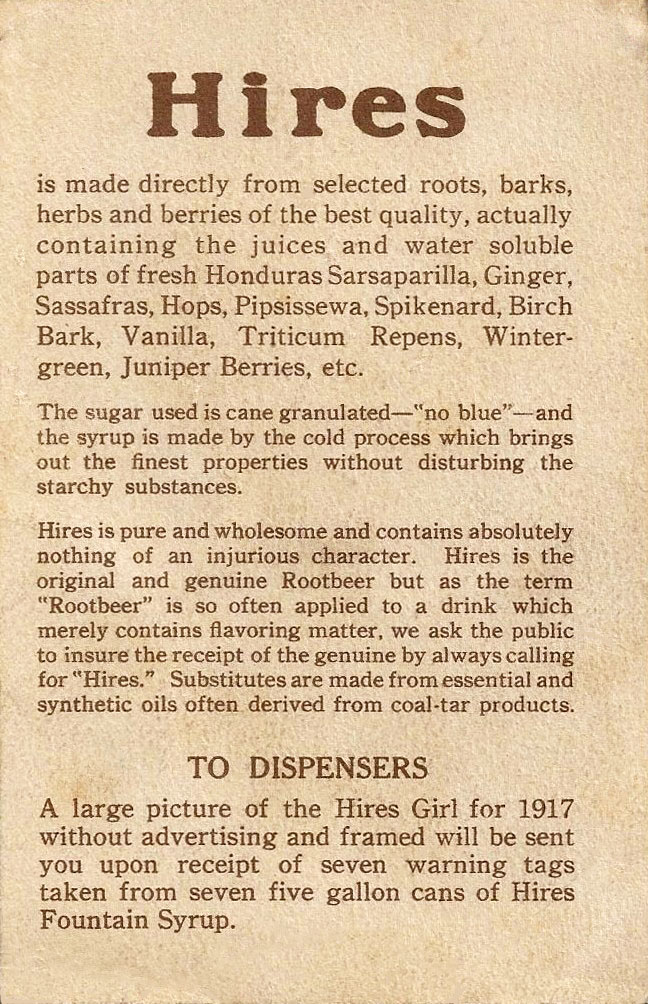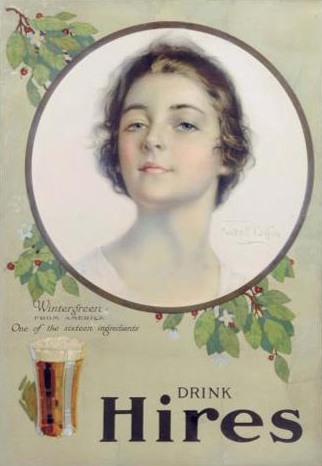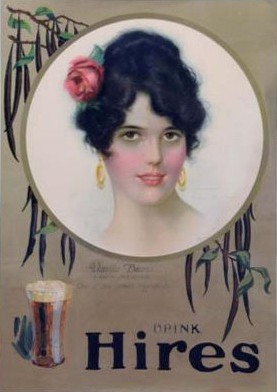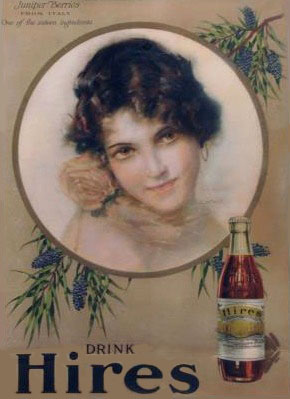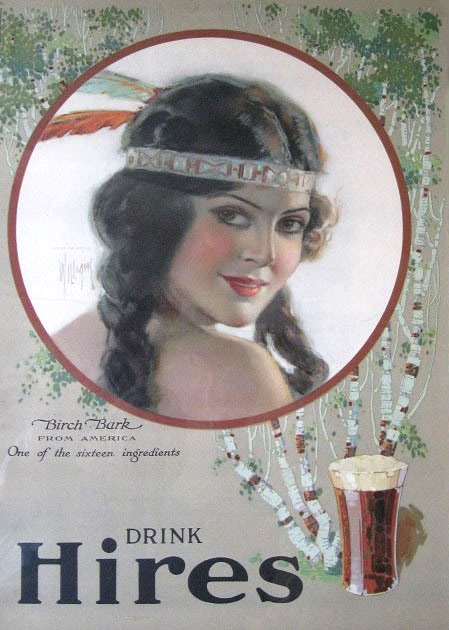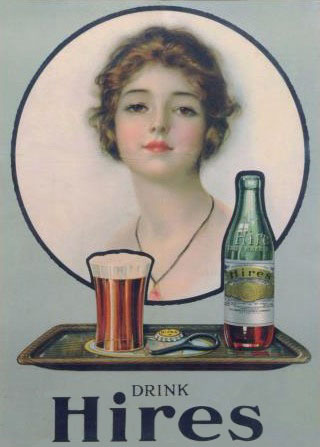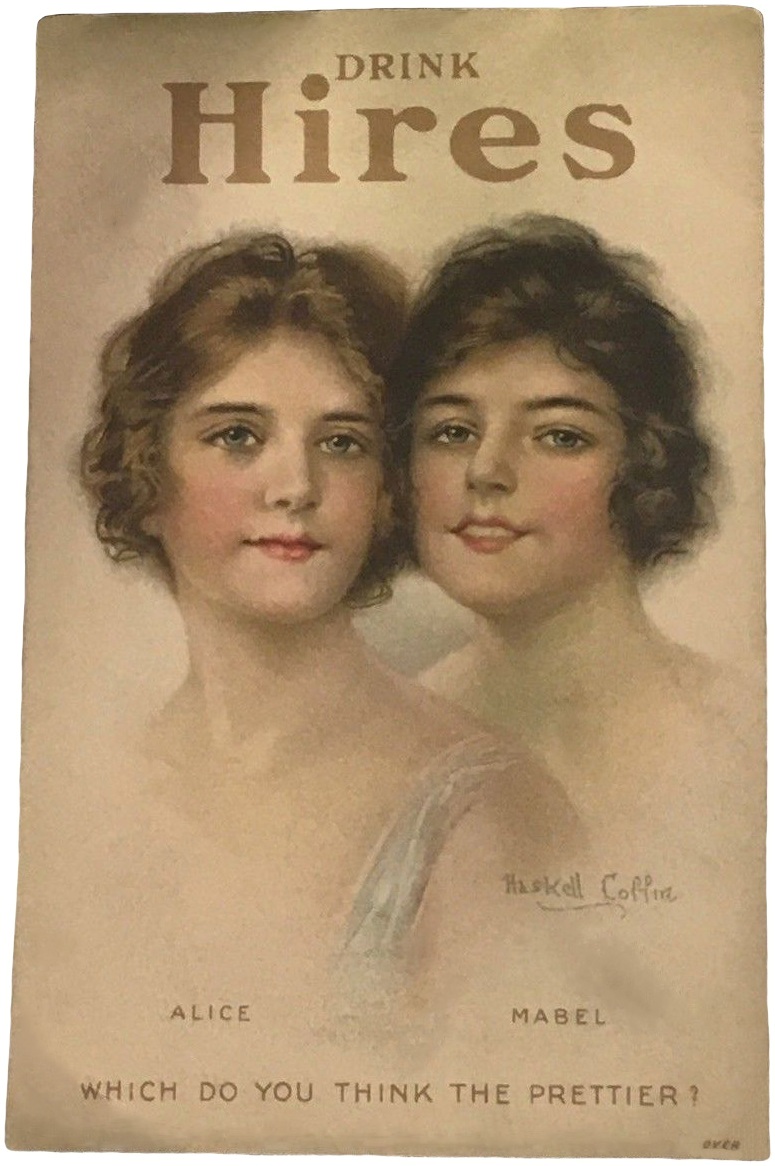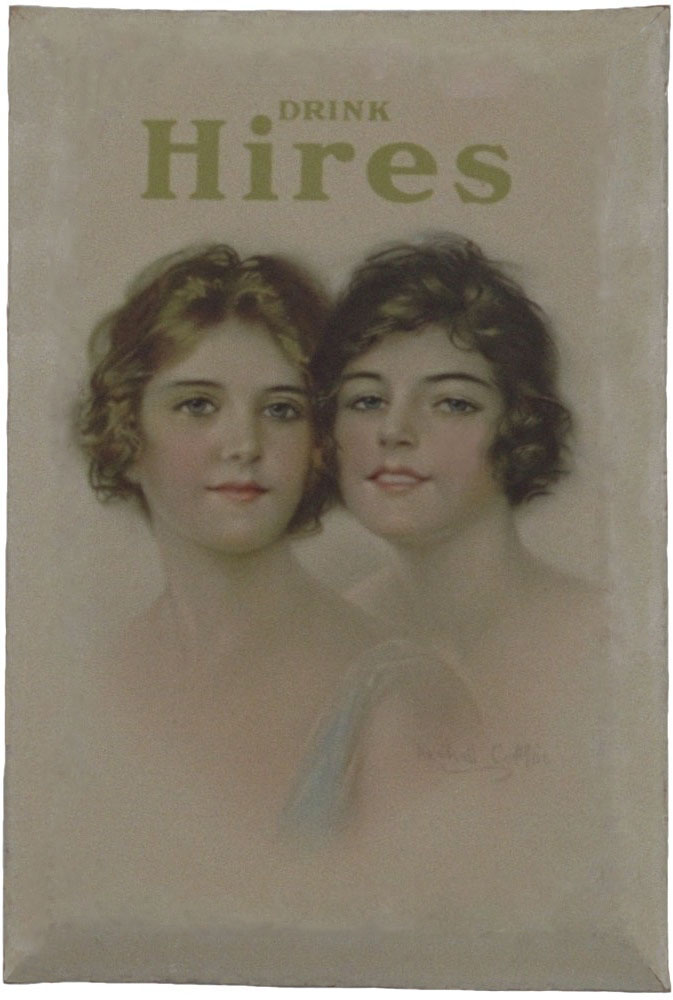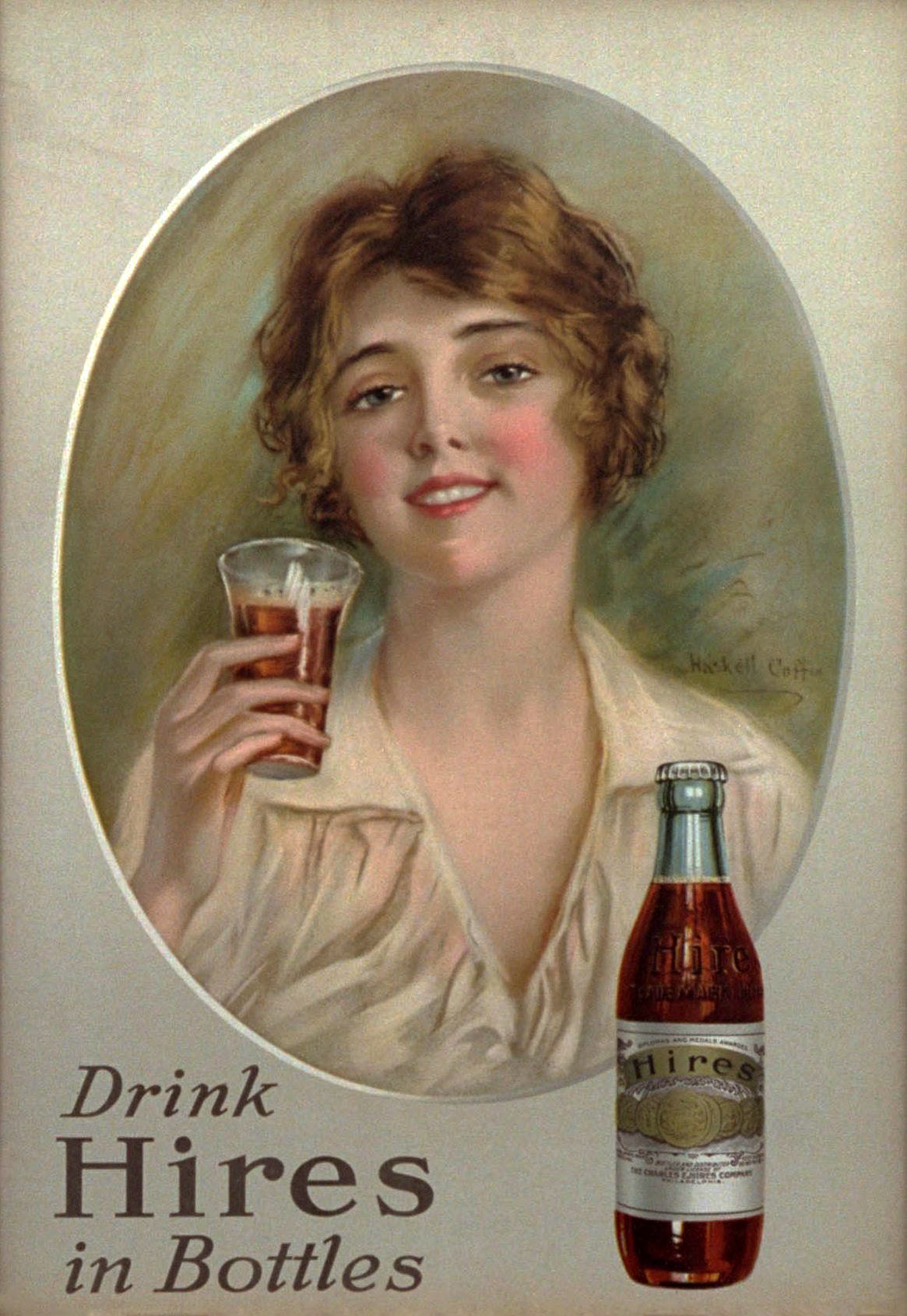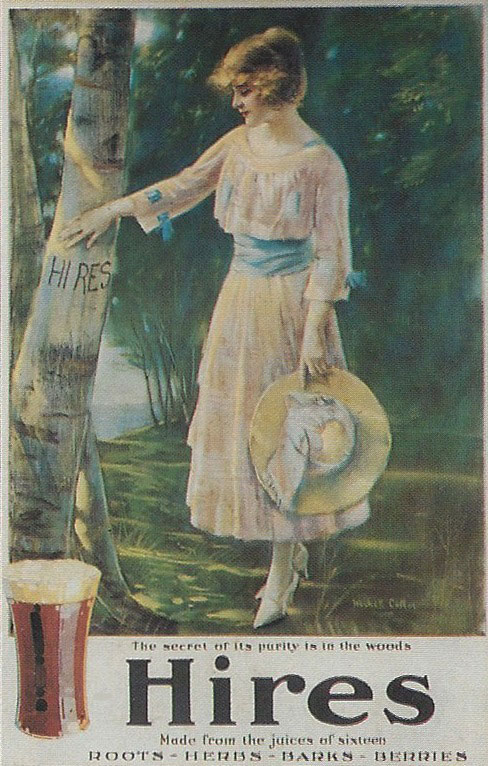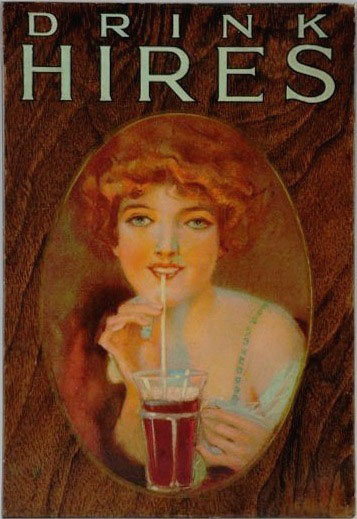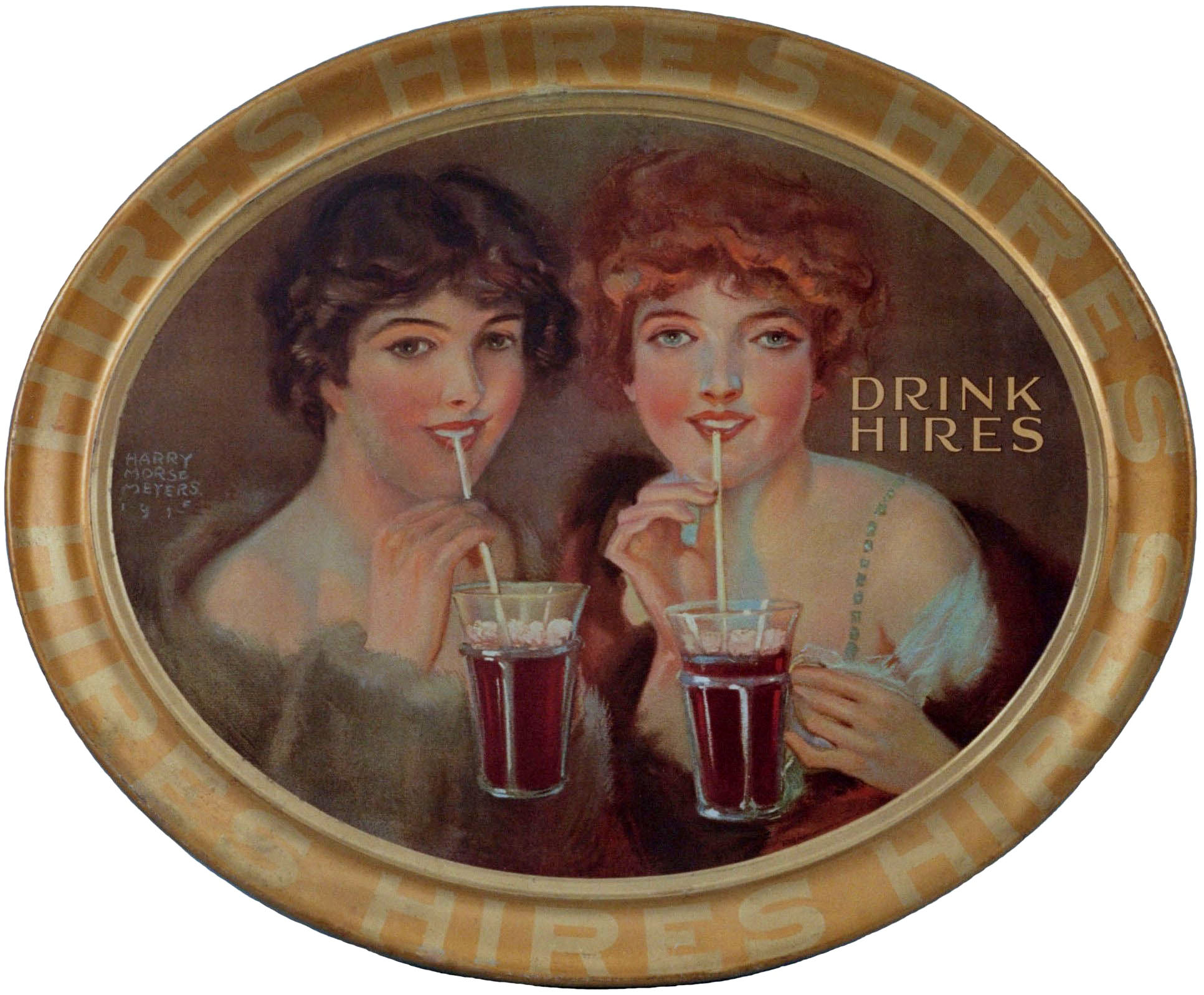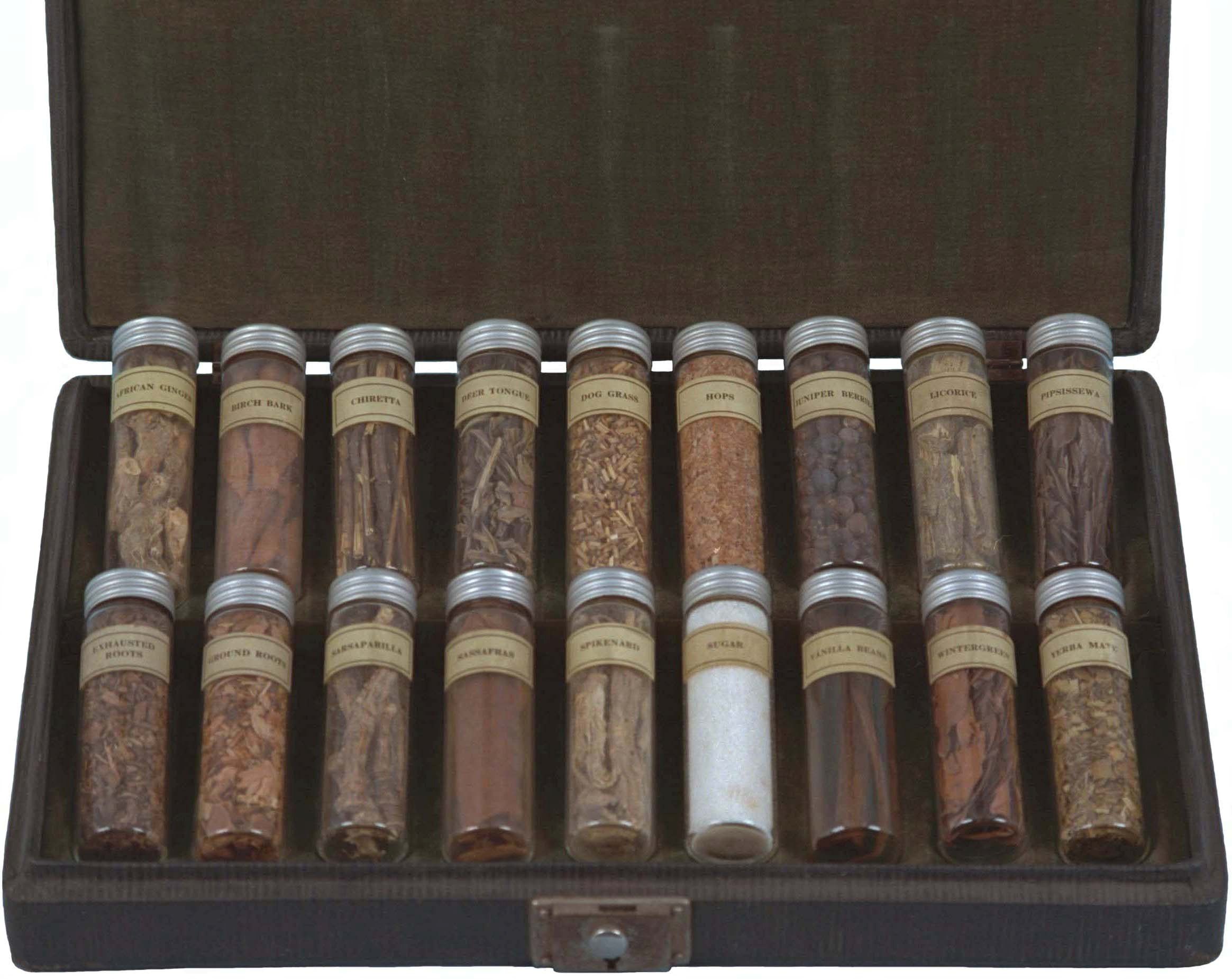1917
IT HAPPENED IN…1917
President Woodrow Wilson delivered this war
message to Congress April 2nd: “The world must be made
safe for democracy.”
The first U.S. troops landed in France on June 27th.
To support recruiting and promote the sale of war
bonds and stamps, advertisers featured war themes in their marketing
campaigns and the media contributed advertising space.
Congress passed the Eighteenth Amendment to the
U.S. Constitution outlawing the manufacture, sale, or transportation
of alcoholic liquors.
The House and Senate overrode President Wilson’s veto and
Prohibition was scheduled to begin January 17, 1920.
Both sides of this cardboard hanger are identical.
(Figure 1917-01, cardboard hanger, 11.0” x
3.125”, courtesy of Mike Godown)
This bottle topper was produced for in-store sales displays. The Hires Boy is pictured using a straw to drink Hires Rootbeer from a bottle bearing a gold medals paper label.
(Figure 1917-02, cardboard bottle topper,
courtesy of Mike Godown)
A similarly designed bottle topper featured an attractive young woman also pictured drinking Hires Rootbeer from a bottle bearing a gold medals paper label.
(Figure 1917-02.5, cardboard bottle topper,
10.0" x 6.0")
Hires crown caps were available from W. H. Hutchinson & Son, a Chicago-based supplier of soda water flavors and coloring, bottle caps, and bottlers’ machinery and supplies. The 1917 Catalog and Price List of W. H. Hutchinson & Son included this information about their crown caps:
(Figure 1917-03, 1917 W. H. Hutchinson & Son Catalog, courtesy of Zang Wood)
(Figure 1917-04, Hires’ 1917 crown cap)
This Hires crown cap was custom made for Reichert Bottling Works in Red Wing, Minnesota. The contents wording helped ensure compliance with Food & Drug Administration labeling requirements.
(Figure 1917-05, Hires crown cap)
A similar crown cap was produced for Wenatchee Bottling Works in Wenatchee, Washington.
(Figure 1917-05.5, Hires crown cap, courtesy of Seth Miller)
In
1917 Charles E. Hires authored A
Short Historical Sketch of the Old Merion Meeting House, Merion, PA.
Completed about 1715, the Merion Friends Meeting House is the
second oldest Friends meeting house in the United States.
Charles E. Hires was responsible for the initial restoration of
the Old Merion Meeting House.
The Hires Board of Directors approved the purchase of
equipment necessary to manufacture Choc-o-la on April 30, 1917.
Hires Choc-o-la (“Pronounced Chock-o-lay.
Lay is Old French For Milk”) was an instant hot chocolate product.
Two different versions of a 6.0" x 3.75" tri-fold brochure picture the
same young girl on the front cover. T
(Figure 1917-06, Hires
Condensed Milk Co. - Choc-o-la brochure)
(Figure 1917-06, Charles E. Hires,
Chemist -
Choc-o-la brochure)
(Figure 1917-06, Hires
Choc-o-la brochure pages 2 & 3)
B. S. Janney, Jr., & Company, Inc. in Philadelphia,
Pennsylvania published this advertisement for Hires Silver Condensed
Milk.
(Figure
1917-07, The
Grocers Guide, cover, June 2, 1917)
The Grocers Guide
wholesale price for Hires Silver Condensed Milk was 15.4¢ per can.
(Figure
1917-07, The
Grocers Guide, Hires Silver Condensed Milk listing)
A Haskell Coffin illustration of an attractive young woman was selected for the “Hires Girl for 1917” trade card. This was the first of several Hires advertising items bearing this illustration.
(Figure 1917-08, “Hires Girl
for 1917” trade card, front, 3.25” x 5.0”)
(Figure 1917-08, “Hires Girl
for 1917” trade card, back, 3.25” x 5.0”)
The "Hires Girl for 1917" trade card mentions offering a large paper poster of the Haskell Coffin picture “without advertising and framed” for those who remove and submit the warning tags from seven five gallon cans of Hires Fountain Syrup. Here's the poster; note it includes advertising copy:
(1917-09, “Hires Girl for
1917” framed paper poster, 15.5” x 23.5”)
The back of the "Hires Girl for 1917" trade card
published for distribution to customers included the same advertising
copy as the version distributed to Hires’ dealers, except the poster
offer reads “A large picture of the Hires Girl for 1917, size 21 x 28,
without advertising, suitable for framing, may be had for six unused two
cent postage stamps.”
(Figure 1917-10, “Hires Girl
for 1917” celluloid over tin sign, 7.0” x 9.75”)
(Figure 1917-11, “Hires Girl
for 1917” tin serving tray, 13.0” x 10.5”)
Expanding Hires’ listing of ingredients from 12 to 16
in 1917 provided an advertising opportunity to produce a series of “One
of the sixteen ingredients” posters featuring portraits of attractive
young women. Haskell Coffin
prepared the artwork for this poster highlighting wintergreen.
(Figure 1917-12, “Wintergreen”
paper poster, 23.0” x 17.5”)
"Vanilla Beans from Mexico” was drawn by Frank H. Desch, an American painter and illustrator who worked in both Massachusetts and New York.
(Figure 1917-13, “Vanilla
Beans from Mexico” paper poster, 24.0” x 18.5”)
These two versions of “Juniper Berries from Italy” were illustrated by C. H. Taffs, a New York artist:
(Figure 1917-14, “Juniper
Berries from Italy,” paper poster, 24.0” x 18.5”)
(Figure 1917-15, “Juniper
Berries from Italy,” paper poster, 26.0” x 20.25”)
A
"Birch Bark from America” paper poster measuring 24.0" x 18.5" was drawn
by an artist named Williams.
(Figure 1917-16, “Birch Bark
from America,” courtesy of Mike Godown)
Haskell Coffin also illustrated this poster.
The model appears to be the same woman pictured on the
“Wintergreen” poster. Note
the excellent detail for the bottle embossing and paper label, opener,
crown cap, full glass of root beer, and serving tray.
(Figure 1917-17, paper poster,
23.0” x 17.5”)
As a follow-up to the "Hires Girl for 1917" campaign, Hires produced "Alice and Mabel" trade cards picturing two attractive young ladies, along with the question "Which do you think the prettier?" The advertising copy on the back of the card suggested readers pick their favorite and notify Hires while also submitting 15¢ in stamps and in return they would receive a 15.0" x 21.0" copy of the Alice and Mabel print. A "Hires Girl for 1918" was never named, so apparently this advertising approach was abandoned and we'll never know the results of the voting.
(Figure 1917-17.5, "Alice and
Mabel" trade card, front, 3.5" x 5.0")
(Figure 1917-17.5, "Alice and
Mabel" trade card, back, 3.5" x 5.0")
Alice and Mabel were also featured on this celluloid
over tin sign.
(Figure 1917-18, celluloid
over tin sign, 6.5” x 9.0”)
Here's yet another poster drawn by Haskell Coffin.
(Figure 1917-19, paper poster,
22.0” x 16.0”)
Note “HIRES” carved into the tree depicted in this
poster drawn by Haskell Coffin.
(Figure 1917-20, paper poster,
12.0” x 19.0”)
In
addition to an eye-catching front cover and historical information,
The Hires Story booklet
contains a smaller-sized version of Haskell Coffin’s “The secret of its
purity is in the woods” poster.
(Figure
1917-21, The
Hires Story, cover, 7.0” x 10.0”)
Harry Morse Meyers, a New York City-based magazine
illustrator, produced this sign.
(Figure 1917-22, tin over
cardboard sign, 6.5” x 9.25”)
The young woman Harry Morse Meyers pictured on the previously illustrated tin over cardboard sign appeared on an oval, tin sign in combination with another attractive young woman. This duo are using straws to enjoy sipping Hires Root Beer from glasses.
(Figure 1917-23, tin sign,
23.5” x 20.0”)
Hires’ salesmen used this leather, felt-lined presentation case that
displayed glass vials containing the 16 roots, herbs, barks, and berries
used as ingredients for Hires Root Beer, plus two vials containing
Exhausted and Ground Roots.
Top row, left to right: African Ginger; Birch Bark; Chiretta; Deer
Tongue; Dog Grass; Hops; Juniper Berries; Licorice; and Pipsissewa.
Bottom row, left to right: Exhausted Roots; Ground Roots;
Sarsaparilla; Sassafras; Spikenard; Sugar; Vanilla Beans; Wintergreen;
and Yerba Mate.
(Figure 1917-24, salesman’s
presentation case, closed, 9.0” x 14.0”)
(Figure 1917-24, salesman’s
presentation case, open, 9.0” x 14.0”)
Charles E. Hires Company sales for 1917 were listed
as 235,136,171 glasses.


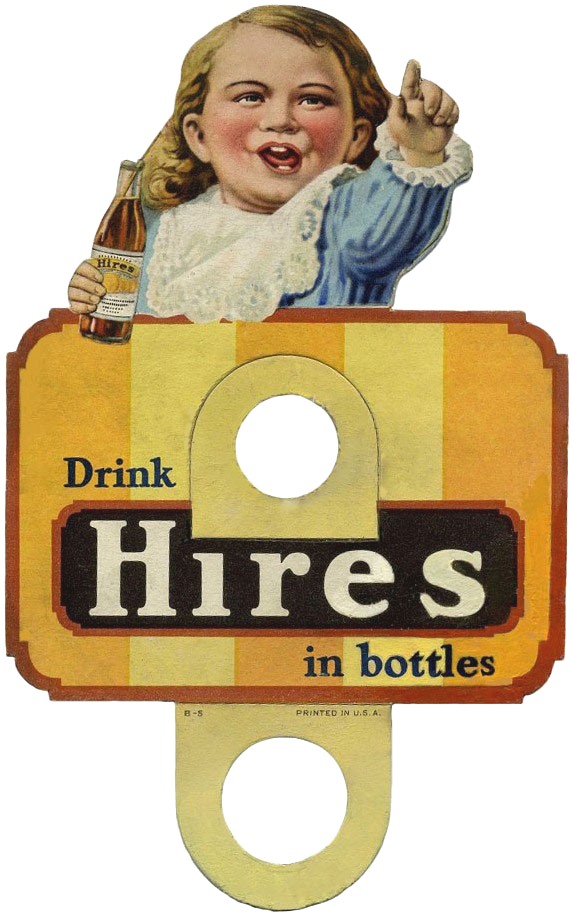
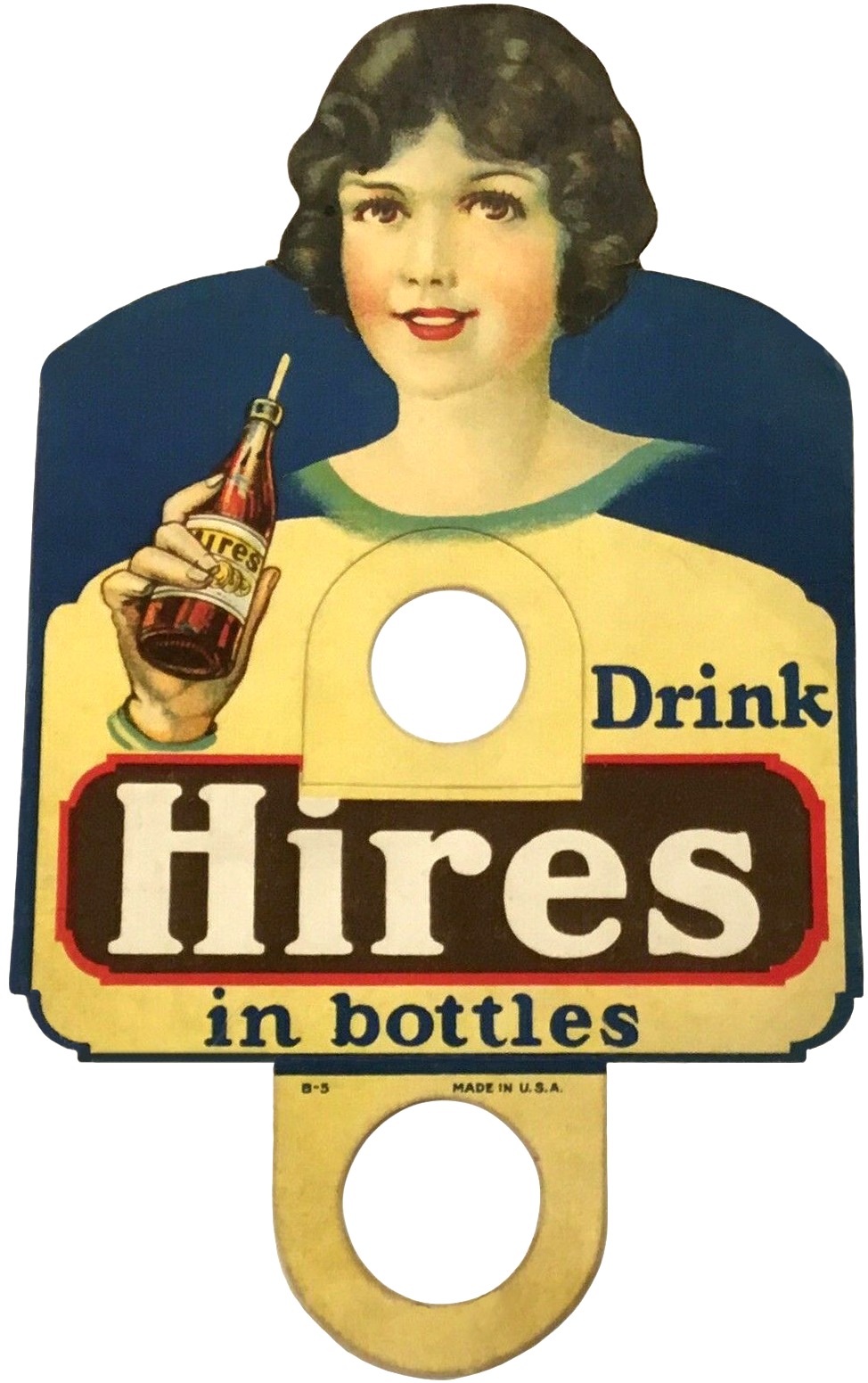



%20crown%20cap%20-%20Wenatchee%20Bottling%20Works%202%20stars%20%20Net%20Contents%206.5%20FL.%20OZ.%20Wenatchee,%20Washington%20courtesy%20of%20Seth%20Miller.jpg)

